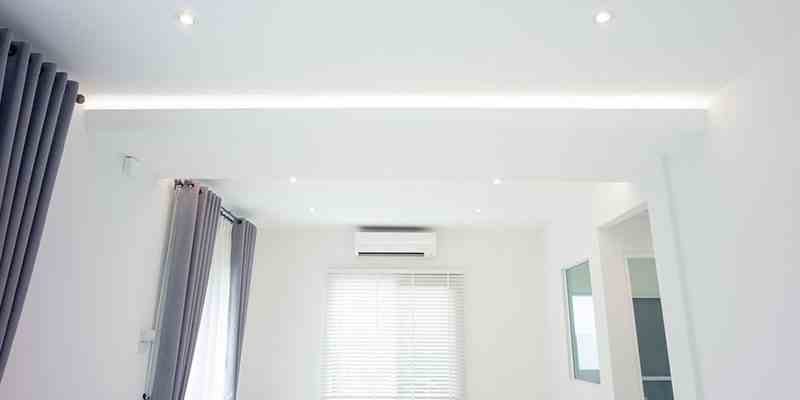What is the LED profile?
The profile for LED light strips is a hollow and long element reminiscent of the shape of a gutter in which flexible LED light strips are inserted. These can be fixed in various ways and are thus protected by the profile from bad weather, shocks or tearing. The LED profile also has a aesthetic rolesince it can make it possible to hide the ribbons and to allow only the light to pass.
LED profiles can be made of various materials, although the aluminum LED profile is the most widespread today, as it is more practical and easier to implement.
The types of LED profiles available on the market
There are several types of LED profiles on the market which differ mainly in their shapes and fixing methods, but also in other specificities. You can realize the diversity of LED profiles by consulting the models of LED profiles on boulevard-des-leds.fr.
The flat aluminum profile
It is characterized by its small footprint, because it is thinner than the others. It is intended to be attached to walls, furniture, ceilings, bars or even headboards. Its flat shape allows hide and fix the LED strip discreetly and to avoid creating a groove visible or perceptible to the touch. It is one of the most used profiles indoors, especially for LED strips used to create ambient lighting and indirect lighting.
Because it is made of aluminum, it is easy to implement and can be cut to the desired length. He is durable and has a long lifespan while requiring very little maintenance, since it is protected against chemical attack and wear. He can, moreover, be personalized by self-adhesive coatings, paints or textures. It is also resistant to fire and heat and allows efficient dissipation of the latter.
The recessed LED strip
Thicker than flat tape, it can be recessed in all mediums, whether walls of various materials, ceilings, floors or furniture. However, it requires the digging of a groove with dimensions compatible with those of the profile. It is available in several thicknesses to adapt to all needs and all types of LED strips. The recessed LED profile is ideal for showcasing an architectural feature or mark steps or other obstacles indoors or outdoors.
The rectangular LED profile
It is suitable for framing doors, windows or railings. It also exists in various thicknesses and heights and is fixed by screwing or gluing. Also called corner profile, it allows you to harmonize the corners around the elements already mentioned and to hide certain visual defects such as the joints, the interstices between a wall and the frame of a door.
The cornice LED profile
It is installed on the walls, a few centimeters from the ceiling to accommodate an LED strip whose light is directed upwards. It therefore allows create indirect ambient lighting cozy and elegant. It is more visible than all other LED profiles, as it has a mainly aesthetic function.
The waterproof LED profile
It is a profile that can be built-in type, cornice type or rectangular type. It has seals and other elements that make it watertight, which makes it perfectly suitable for outdoor installation, in a damp room or in a child’s room. He is very secure, robust and durable. For it to be truly watertight, this profile must be certified to the IP54 standard for the protection index and IP65 for watertightness.
The LED profile for plasterboard
It is specially designed to be integrated into placo structures. This profiteer is usually made of aluminum and is U-shaped or L-shaped to easily integrate with plasterboard. It is used for indirect lighting in interior spaces (living room, bedroom, office, kitchen).
It allows the creation of decorative lighting effects and can be used to highlight shelves, cornices or niches.
The advantages of the LED profile
If the LED profile is now so widely used in interior and exterior decoration, it is for its many advantages.
It adapts to all configurations
Thanks to the diversity of its fixing methods, its shapes and its dimensions, it is possible to find an LED profile suitable for all uses. It can therefore be installed in bedrooms, living rooms, bathrooms, kitchens and outdoors.
The greatest strength of the LED profile is therefore the diversity of its applicationswhether the LED strip has a purely aesthetic function or whether it is placed to bring light or signal an element such as a step or a railing.
It protects the LEDs and maintains beautiful lighting
The LED profile accommodates the flexible LED strips and protects them. It creates a barrier against dust and dirt while protecting the tapes against shocks and the risk of tearing or cutting. It is therefore an investment that makes it possible to offer LED strips an even longer lifespan.
An aesthetic asset
The LED profile is also a undeniable aesthetic advantage. The flat aluminum LED profile, for example, makes it possible to smooth the surfaces around the LED strip and make it invisible. Thus, only the light emitted by the ribbon is visible, which is a interesting advantage for interior decoration. The cornice profiles allow, for their part, to highlight the volumes and the heights under the ceiling thanks to indirect and soft lighting.
The profiles are also customizable as desired, since it is possible to decorate them with various coatings and give them the appearance of various materials such as wood or concrete. It can therefore be very discreet while perfectly fulfilling its protective function.

